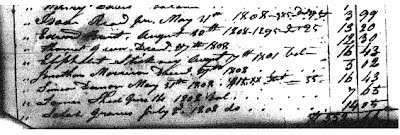THEY DIDN’T POSE FOR NORMAN ROCKWELL
Turning Family Drama Into a Bridge Across the Atlantic
For many years, I’ve known that my ancestor, Joseph Francis, was divorced from his wife, Lucetta Luhr (Clark) Francis, in 1869. She filed for and was granted a divorce in Adams County, Illinois, where she’d taken the children to live with her mother. This must have been especially difficult, being unusual for the era. But, I felt fortunate that the divorce papers clearly stated their children’s names, birth places, and birth dates.
Fast forward, to a research trip in the more recent past to the Family History Library in Salt Lake City. What I learned had never occurred to me: while Lucetta was suing Joseph Francis for divorce, he was counter-suing her across the Mississippi River, in Lee County, Iowa, where they had lived as a couple in Fort Madison. It would have taken me half a day to photocopy the many pages of the complete Iowa case, all of which had been microfilmed. (After I returned home, I ordered the film at my local LDS branch library and made copies.) While Lucetta’s case against her husband described his low habits, Joseph supplied many depositions attacking his wife’s character. And, buried among them, was one from his German-born mother-in-law (clearly supplied unwillingly). The mission was obviously to establish a familial history of “loose women.” I can imagine a TV attorney screaming “Objection!” to the questions! However, for my purposes, they proved to be a gold mine.
Until now, I’d only had a brief sketch of Lucetta’s mother, based on a short county history, obituary, and census records. She was born Doris Frantz, perhaps in Domitz, Mecklenburg-Schwerin, and widowed about 1844 in Portsmouth, Ohio. Joseph Francis’ divorce papers supplied so much more: Doris’ approximate date of birth, HER mother’s name, when Doris’ parents had died, when she had been first married, when and where she’d first had children, about when she came to America, where she had first lived (Buffalo, New York, unknown to me), when and where she had married her second husband, Charley Clark (Canada: again, news to me). Using the marvelous resources of the library, I set to work. I had a rare run of luck: there was only one town in present-day Germany that looked close to what I wanted, it was in Mecklenburg-Schwerin, the records were filmed, and they had a surname index. (Trust me, it’s only happened once!) It still required careful study of unfamiliar writing and language, and much trotting up to the help desk, so that the gracious, multi-lingual staff could translate what I was seeing.
I now have more details than I would have thought possible to get for my 2nd great grandmother, Dorothea Maria Augusta Franz. So far, I have her birth date, christening date, confirmation date, marriage date, complete names of her parents, grandparents, occupations, and so on. I have the same details for her husband, who I only knew as Frederick Luhr, but who was born Johann Joachim Friedrich Luhr. He came from Lubtheen, a village close to that of his future wife. I hope to find earlier generations in this family, but it will take careful reading.
I’ll never know the whole story behind my ancestors’ divorce, but I do know I have been reminded of the same, basic lessons: look for ALL the records in ALL the locations. And, keep reading that old handwriting; you’ll be surprised at what’s hiding there.




.JPG)
.JPG)



.jpg)










